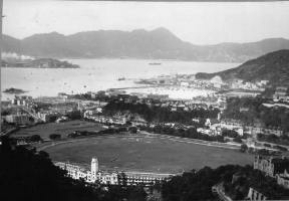| |
The
Mainland Evacuated ...
By nightfall of December 13th the evacuation of the mainland was
successfully completed. Despite continuous attack it was orderly
and there were surprisingly few casualties. Unfortunately much
of Wallis' heavy equipment had to be left behind.

Pictured is
The Happy Valley Race Course with The Jockey Club in the
foreground and Causeway Bay in the background.
The Japanese took command of
Kowloon, a terrified city in total chaos, marched triumphantly
through the city with prisoners being prodded along at bayonet
point. The Japanese officers declared Kowloon an 'open city' and
branding all Chinese women as prostitutes they left the people
to the tender mercies of their soldiers. History records that
what followed was an unbridled orgy of raping, looting, torture
and murder.
From
Major Parker's Memories ...
The following was written by Major M.A. Parker, Commanding
Officer "D" Company, Royal Rifles of Canada, in 1982. He used
notes which he had written in a diary while in captivity and
kept for more than 37 years. They are his observations made
about the fighting on the mainland, and about the senior
leadership. He had not changed his mind in 1982, so was not
looking back with 20/20 hindsight. If anything, his opinion was
even firmer, and was shared by other officers of the Royal
Rifles.
"The Mainland Brigade was commanded by Brigadier Cedric Wallis
who had previously commanded the 5/7 Rajputs. Wallis was a
dedicated and energetic officer whose personal courage was
beyond question, but some of the Canadians, particularly the
Royal Rifles, were subsequently to question his military
judgement. “The Gin Drinkers Line had collapsed, Brigadier
Lawson, in a telephone conference with Brigadier Wallis, could
get little information from him, or his staff, and we were under
the impression that a large battle was being fought on the
mainland. It turned out that fighting on the mainland was
minimal, and that total casualties were very few. We were
astonished to see the mainland turned over to the enemy in only
5 days, and judging from the casualties, without much of an
attempt to stop them. Was Wallis a little bit rattled?
“We were assured that the demolitions on the mainland had
been so extensive that it would take many weeks before the
Japanese could bring up their artillery. The next day the first
heavy shells began exploding on Hong Kong Island.”
There was a certain amount of tension between the British and
the Canadians at the Field Officer level. The British thought
the Canadians were a rag-tag bunch of rowdy, cowardly colonists,
not good for very much. Much to the consternation of the
Canadians some British historians have written as much. The
Canadians thought of the British as arrogant, condescending
prigs. They also thought they were wrong to hold fast to the
idea that attack would come from the sea..
It was at this point, as the mainland troops were returning to
Hong Kong on December 13th, that General Maltby took stock of
the situation and decided to re-deploy his troops into two
Brigades, the East Brigade, under Wallis, and the West Brigade
under Brigadier Lawson. Major Parker says. "A major
disadvantage of this new arrangement was that the Canadian
Battalions were separated and only one remained under Canadian
Brigadier Lawson's command. The Canadians were not very happy
with this arrangement ... but little could be done about it.
This seemed unfortunate at the time and was to prove
increasingly so during the battle and in post-battle
repercussions".
The Hong Kong defenders were still dueling with the Japanese
artillery units across the mile-wide strait separating the
island from the mainland and had dispersed several Japanese
troop concentrations, silencing two of their artillery sections.
Japanese planes were also bombing positions on the island and
the situation was getting grimmer by the hour. Governor, Sir
Mark Young, had refused a Japanese summons to surrender.
"Military men in London agreed that the island could not hold
out indefinitely because of the problem of supplies. There were
1,500,000 Chinese civilians to feed, besides the defense forces.
There were in fact enough supplies laid up in Hong Kong to last,
as mentioned, 120 days. The problem was there were not enough
men to last that long."
The Eve of Battle
The only effective forces left in the East Brigade were the
Royal Rifles of Canada, some Middlesex Machine Gunners, and some
HKVDC units. The Rajputs were exhausted at rest in the rear
echelon. All troops were sleep deprived, tired and hungry. On
the night of December 16th the Japanese made a probing attack
which, in spite of their exhaustion, was beaten back by "C"
Company of the Royal Rifles.
From an interview with Rifleman John
Beebe...
"From December 8th to 18th the battle went on at a distance,
but with the Japs pushing down in force and getting closer and
closer. By that time they had surrounded Kowloon and then on the
18th they succeeded in crossing to the island in heavy fog. From
then on, it was hand-to-hand with cold steel."
The Japanese occupied the mainland from Kowloon to Devil's Peak.
On the night of December 17th. they began a heavy bombing and
artillery barrage of the island's northern coastal defenses from
North Point in the northwest to Fort Sau Ki in the northeast
knocking out many of the pill box machine guns manned by the
Middlesex Regiment. They had amassed thousands of troops, tons
of equipment, and hundreds of small craft, all without causing
any doubt in the mind of General Maltby that the main attack
would come from the South.
________________________________________
|
